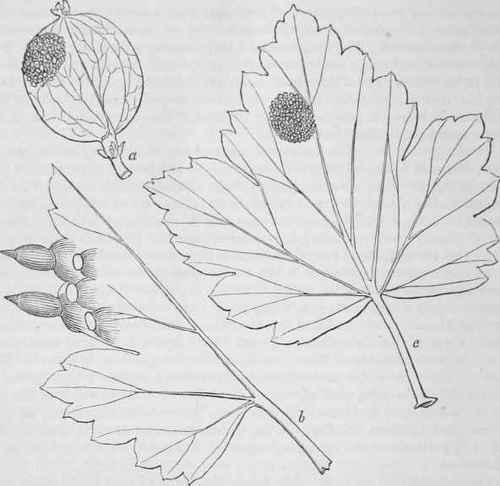A Disease Of The Gooseberry. How To Get Rid Of It, Etc
Description
This section is from the book "The Gardener V1", by William Thomson. Also available from Amazon: The New Organic Grower: A Master's Manual of Tools and Techniques for the Home and Market Gardener.
A Disease Of The Gooseberry. How To Get Rid Of It, Etc
Aecidium Cancellatum
A, a berry upon which it is seen growing in its natural size; b, leaf cut showing the part where the peridia are magnified; c, a full-sized leaf affected as the berry, appearing like a drop of red paint at a distance.

Fig. 27.
Aecidiuh (Persoon)
Aecidiuh (Persoon), a genus of plants belonging to the natural family of Fungi, or the Mushroom tribe, and to the class Cryptogamia of Linnaeus. This Fungus consists of small membranous sacs or protuberances, which are found parasitic on the leaves, bark, fruit, etc. of several plants; such as the Fir, Violet, Barberry, Hawthorn, Primrose, Nettle, etc. The membrane forming the sac has received the name of peridium. It pierces the bark or epidermis of the leaves, and encloses very minute dust-like seeds or sporules, which are ultimately discharged by an opening in its side or summit. In consequence of the seeds being contained in a membrane, the genus has been referred to a division of fungi which has been denominated Angiocarpi. There are upwards of thirty known species of the genus, and they receive their names from the plants on which they are found. Link has divided this genus into three sub-genera, the AEcidium properly so called, the Raestelia, and Peridernium. The AE. cancellatum here represented belongs to the second of those divisions. It is often found on the leaves of Pear-trees. To the third division belongs the ae. pini, remarkable for being the largest species, and for growing not upon the leaves but upon the bark of the Pine-tree. They vary in colour.
The species that grow on the Gooseberry and Barberry leaves are red; that found on the Scotch Fir is yellow, and that on the Meadow Rue bright orange. The aecidia cause considerable deformities in the plants on which they grow, and some of them are decidedly injurious and poisonous. The Gooseberry aecidium is said frequently to destroy the young fruit of that plant, which we are quite satisfied to believe; the species found on the Barberry has been stated, though perhaps erroneously, to be hurtful to corn growing near it; but as some of our horticultural friends may be desirous to know how to subdue this pest, and erase it from their Gooseberry plantations, I will give my experience on this point, and how I have gained a perfect cure. In 1868 and 1869, about one-third of the fruit here (Mouswald Gardens, Dumfries, seat of Sir James J. Reid) became blotched very much by this fungus. I give the ground amongst the bushes a liberal dressing with lime in the autumn, and syringe them over with a compound of alum 1 drachm, tobacco essence 2 drachms, flower of sulphur half an ounce, common salt three-quarters of an ounce, all mixed in 3 gallons of rainwater; this was done twice before the expanding of the leaf, and again as soon as the fruit appeared fairly set.
This first destroyed the mycelium in the soil, and the syringing cleared the bark of its sporules; and my Gooseberry-bushes are now free from all trace of fungus. John Graham.
Mouswald Gardens, Dumfries.
Continue to:


